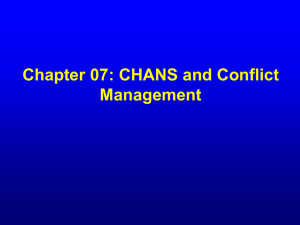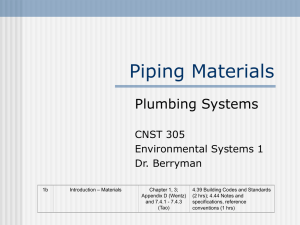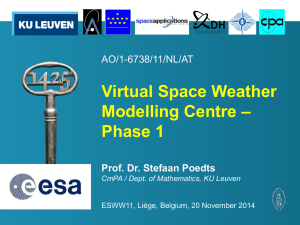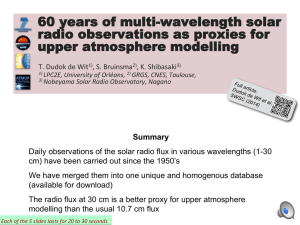Wave functions
advertisement
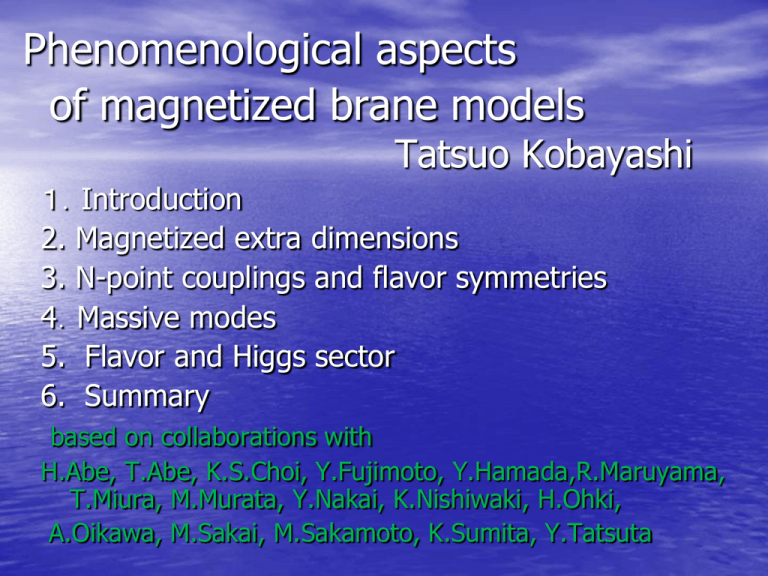
Phenomenological aspects
of magnetized brane models
Tatsuo Kobayashi
1.Introduction
2. Magnetized extra dimensions
3. N-point couplings and flavor symmetries
4.Massive modes
5. Flavor and Higgs sector
6. Summary
based on collaborations with
H.Abe, T.Abe, K.S.Choi, Y.Fujimoto, Y.Hamada,R.Maruyama,
T.Miura, M.Murata, Y.Nakai, K.Nishiwaki, H.Ohki,
A.Oikawa, M.Sakai, M.Sakamoto, K.Sumita, Y.Tatsuta
1 Introduction
Extra dimensional field theories,
in particular
string-derived extra dimensional field theories,
play important roles in particle physics
as well as cosmology .
Extra dimensions
4 + n dimensions
4D ⇒ our 4D space-time
nD ⇒ compact space
Examples of compact space
torus, orbifold, CY, etc.
Field theory in higher dimensions
10D ⇒ 4D our space-time + 6D space
10D vector
AM A , Am
4D vector + 4D scalars
SO(10) spinor ⇒ SO(4) spinor
x SO(6) spinor
internal quantum number
Several Fields in higher dimensions
4D (Dirac) spinor
i
D 0
⇒ (4D) Clifford algebra { , } 2
(4x4) gamma matrices
represention space ⇒ spinor representation
6D Clifford algebra
{ M , N } 2 MN
M
4
( M 0,1,2,3)
,
I 44
5
6D spinor
6D spinor
I 44 1 ,
3
2
4 D 2 D
⇒ 4D spinor x (internal spinor)
internal quantum
number
Field theory in higher dimensions
Mode expansions
M
M Am ( 6 ) Am 0
i ( D m Dm ) 0
KK decomposition
KK docomposition on torus
torus with vanishing gauge background
Boundary conditions
( y4 1, y5 ) ( y4 , y5 )
( y4 , y5 1) ( y4 , y5 )
0 : constantmode
n : exp(ikny) k 2 / R
We concentrate on zero-modes.
mn 0
mn kn
Zero-modes
Zero-mode equation
i Dm 0
m
⇒ non-trival zero-mode profile
the number of zero-modes
4D effective theory
Higher dimensional Lagrangian (e.g. 10D)
L10 g d xd y ( x, y ) A( x, y ) ( x, y )
4
6
integrate the compact space ⇒ 4D theory
L4 Y d x ( x) ( x) ( x)
4
Y g d y ( y ) ( y ) ( y )
6
Coupling is obtained by the overlap
integral of wavefunctions
Couplings in 4D
Zero-mode profiles are quasi-localized
far away from each other in compact space
⇒ suppressed couplings
Chiral theory
When we start with extra dimensional field theories,
how to realize chiral theories is one of important
issues from the viewpoint of particle physics.
i Dm 0
m
Zero-modes between chiral and anti-chiral
fields are different from each other
on certain backgrounds,
e.g. CY, toroidal orbifold, warped orbifold,
magnetized extra dimension, etc.
Magnetic flux
i Dm 0
m
The limited number of solutions with
non-trivial backgrounds are known.
Generic CY is difficult.
Toroidal/Wapred orbifolds are well-known.
Background with magnetic flux is
one of interesting backgrounds.
Magnetic flux
Indeed, several studies have been done
in both extra dimensional field theories
and string theories with magnetic flux
background.
In particular, magnetized D-brane models
are T-duals of intersecting D-brane models.
Several interesting models have been
constructed in intersecting D-brane models,
that is, the starting theory is U(N) SYM.
Phenomenology of magnetized
brane models
It is important to study phenomenological
aspects of magnetized brane models such as
massless spectra from several gauge groups,
U(N), SO(N), E6, E7, E8, ...
Yukawa couplings and higher order n-point
couplings in 4D effective theory,
their symmetries like flavor symmetries,
Kahler metric, etc.
It is also important to extend such studies
on torus background to other backgrounds
with magnetic fluxes, e.g. orbifold backgrounds.
量子力学の復習:磁場中の粒子(Landau)
F45 2b, A4 0, A5 2by4
1
2
2
H
P4 ( P5 2by 4 )
2m
[ H , P5 ] 0
P5 2k
1
2
2 2
2
H
P4 4 b ( y4 k / b)
2m
座標がk/bずれた調和振動子
b個の基底状態
b=整数
k=0,1,2,…………,(b-1)
2. Extra dimensions with magnetic
fluxes: basic tools
2-1. Magnetized torus model
We start with N=1 super Yang-Mills theory
in D = 4+2n dimensions.
For example, 10D super YM theory
consists of gauge bosons (10D vector)
and adjoint fermions (10D spinor).
We consider 2n-dimensional torus compactification
with magnetic flux background.
We can start with 6D SYM (+ hyper multiplets),
or non-SUSY models (+ matter fields ), similarly.
Higher Dimensional SYM theory with flux
Cremades, Ibanez, Marchesano, ‘04
4D Effective theory <= dimensional reduction
The wave functions
eigenstates of corresponding
internal Dirac/Laplace operator.
Higher Dimensional SYM theory with flux
Abelian gauge field on magnetized torus
Constant magnetic flux
gauge fields of background
The boundary conditions on torus (transformation under torus translations)
Higher Dimensional SYM theory with flux
We now consider a complex field
Consistency of such transformations under
a contractible loop in torus which implies
Dirac’s quantization conditions.
with charge Q ( +/-1 )
Dirac equation on 2D torus
is the two component spinor.
U(1) charge Q=1
4 i 5 ,
4 i 5
with twisted boundary conditions (Q=1)
Dirac equation and chiral fermion
|M| independent zero mode solutions in Dirac equation.
(Theta function)
Properties of
theta functions
chiral fermion
:Normalizable mode
:Non-normalizable
mode
By introducing magnetic
flux, we can obtain chiral
theory.
Wave functions
For the case of M=3
Wave function profile on toroidal background
Zero-modes wave functions are quasi-localized far away each
other in extra dimensions. Therefore the hierarchirally small
Yukawa couplings may be obtained.
Fermions in bifundamentals
Breaking the gauge group
(Abelian flux case
The gaugino fields
gaugino of unbroken gauge
bi-fundamental matter fields
)
Bi-fundamental
Gaugino fields in off-diagonal entries
correspond to bi-fundamental matter fields
and the difference M= m-m’ of magnetic
fluxes appears in their Dirac equation.
F
Zero-modes Dirac equations
No effect due to magnetic flux for adjoint matter fields,
Total number of zero-modes of
:Normalizable mode
:Non-Normalizable mode
4D chiral theory
10D spinor
( , )
light-cone 8s
even number of minus signs
1st ⇒ 4D, the other ⇒ 6D space
If all of
appear
in 4D theory, that is non-chiral theory.
If
only
for all torus,
ab
N
a
, Nb ,
appear for 4D helicity fixed.
⇒ 4D chiral theory
U(8) SYM theory on T6
Fzz
m1 N1
2i
0
0
m2 N 2
N1 4, N2 2, N3 2
m3 N 3
U (4) U (2) L U (2) R
Pati-Salam group up to U(1) factors
T 2
(m1 m2 ) (m3 m1 ) 3 for t hefirst
4,2,1 4,1,2
(m1 m2 ) (m3 m1 ) 1 for t heot her t ori
Three families of matter fields
with many Higgs fields
(4,2,1) ( 4,1,2)
(1,2,2)
2-2. Wilson lines
Cremades, Ibanez, Marchesano, ’04,
Abe, Choi, T.K. Ohki, ‘09
torus without magnetic flux
constant Ai mass shift
every modes massive
magnetic flux
2 (My a)
2 ( My a)
the number of zero-modes is the same.
the profile: f(y) f(y +a/M)
with proper b.c.
0
0
U(1)a*U(1)b theory
magnetic flux, Fa=2πM, Fb=0
Wilson line, Aa=0, Ab=C
matter fermions with U(1) charges, (Qa,Qb)
chiral spectrum,
for Qa=0, massive due to nonvanishing WL
when MQa >0, the number of zero-modes
is MQa.
zero-mode profile is shifted depending
on Qb, f ( z) f ( z CQ /(MQ ))
b
a
Pati-Salam model
Fzz
m1 N1
2i
0
Pati-Salam group
0
m2 N 2
m3 N 3
N1 4, N2 2, N3 2
U (4) U (2) L U (2) R
(m1 m2 ) (m3 m1 ) 3 for t hefirst T
2
t ori
(m1 m2 ) (m3 m1 ) 1 for t heot her
4,2,1 4,1,2
WLs along a U(1) in U(4) and a U(1) in U(2)R
=> Standard gauge group up to U(1) factors
U (3)C U (2) L U (1)3
U(1)Y is a linear combination.
(the others are massive.)
PS => SM
Zero modes corresponding to
(4,2,1) ( 4,1,2)
three families of matter fields
remain after introducing WLs, but their profiles split
(4,2,1) (3,2,1) (1,2,1)
( 4,1,2) ( 3,1,1) ( 3,1,1) (1,1,1) (1,1,1)
(4,2,1)
Q
L
Other models
We can start with 10D SYM,
6D SYM (+ hyper multiplets),
or non-SUSY models (+ matter fields )
with gauge groups,
U(N), SO(N), E6, E7,E8,...
E6 SYM theory on T6
Choi, et. al. ‘09
We introduce magnetix flux along U(1) direction,
which breaks E6 -> SO(10)*U(1)
78 450 10 161 161
m1 3, m2 1, m3 1
Three families of chiral matter fields 16
We introduce Wilson lines breaking
SO(10) -> SM group.
Three families of quarks and leptons matter fields
with no Higgs fields
Splitting zero-mode profiles
Wilson lines do not change the (generation)
number of zero-modes, but change
localization point.
16
Q
……
L
2.3 Orbifold with magnetic flux
S1/Z2 Orbifold
There are two singular points,
which are called fixed points.
Orbifolds
T2/Z3 Orbifold
There are three fixed points on Z3 orbifold
(0,0), (2/3,1/3), (1/3,2/3) su(3) root lattice
T2/Z4, T2/Z6
Orbifold = D-dim. Torus /twist
Torus = D-dim flat space/ lattice
Orbifold with magnetic flux
Abe, T.K., Ohki, ‘08
The number of even and odd zero-modes
We can also embed Z2 into the gauge space.
=> various models, various flavor structures
Wave functions
For the case of M=3
Wave function profile on toroidal background
Zero-modes wave functions are quasi-localized far away each
other in extra dimensions. Therefore the hierarchirally small
Yukawa couplings may be obtained.
Zero-modes on orbifold
Adjoint matter fields are projected by
orbifold projection.
We have degree of freedom to
introduce localized modes on fixed points
like quarks/leptons and higgs fields.
Zero-modes on ZN orbifold
Similarly we can discuss
2D ZN orbifolds with magnetic fluxes
for N=2,3,4 and 6.
Abe, Fujimoto, T.K., Miura, Nishiwaki,
Sakamoto, arXiv:1309.4925
3. N-point couplings
and flavor symmetries
The N-point couplings are obtained by
overlap integral of their zero-mode w.f.’s.
Y g d z ( z ) ( z ) ( z )
2
i
M
z y4 iy5
j
N
k
P
Moduli
Torus metric
ds 2(2R) dzdz
z x y
2
2
Area A 4 R Im
We can repeat the previous analysis.
Scalar and vector fields have the same
wavefunctions.
M
Wilson moduli
( z) ( z )
shift of w.f.
2
2
Zero-modes
Cremades, Ibanez, Marchesano, ‘04
( z) N M
j
M
j/M
exp[iMz Im(z )]
( Mz, iM )
0
j 1,, M
N M : normalization factor,
Zero-mode w.f. = gaussian x theta-function
( z ) ( z )
i
M
j
N
M N
y
m 1
ijm
i j Mm
M N
( z ),
up to normalization factor
yijm
( Ni Mj MNm) /(MN ( M N ))
(0, iMN ( M N ))
0
Products of wave functions
2My 0,
2Ny 0,
2 ( M N ) y
M
N
( M N )
( M N ) M N
products of zero-modes = zero-modes
0,
3-point couplings
Cremades, Ibanez, Marchesano, ‘04
The 3-point couplings are obtained by
overlap integral of three zero-mode w.f.’s.
Yijk d z ( z ) ( z )
2
i
M
j
N
k
M N
( z)
*
2
i
k
ik
d
z
(
z
)
(
z
)
M
M
Yijk
*
M N
m 1
i j mM , k
yijm
up to normalization factor
Selection rule
i j mM ,k i j mM k (M N )
i j k
mod g
when g gcd( M , N )
Each zero-mode has a Zg charge,
which is conserved in 3-point couplings.
yijm
( Ni Mj MNm) /(MN ( M N ))
(0, iMN ( M N ))
0
up to normalization factor
4-point couplings
Abe, Choi, T.K., Ohki, ‘09
The 4-point couplings are obtained by
overlap integral of four zero-mode w.f.’s.
split
Yijkl d z ( z ) ( z ) ( z )
2
d
2
i
M
j
N
k
P
l
M N P
( z)
zd z ' ( z ) ( z ) ( z z ' ) ( z ' )
2
i
M
j
N
k
P
insert a complete set
( z z' )
n
K
s
l
M N P
n
( z) K
( z' )
all modes
Yijkl yijs yskl
*
*
up to normalization factor
for K=M+N
( z' )
*
4-point couplings: another splitting
d
2
zd z ' ( z ) ( z ) ( z z ' ) ( z ' )
2
i
M
k
P
j
N
l
M N P
( z' )
Yijkl yikt ytjl
t
Yijkl yijs yskl
Yijkl yikt ytjl
t
s
i
k
i
k
t
j
s
l
j
l
*
N-point couplings
Abe, Choi, T.K., Ohki, ‘09
We can extend this analysis to generic n-point
couplings.
N-point couplings = products of 3-point couplings
= products of theta-functions
This behavior is non-trivial. (It’s like CFT.)
Such a behavior would be satisfied
not for generic w.f.’s, but for specific w.f.’s.
However, this behavior could be expected
from T-duality between magnetized
and intersecting D-brane models.
T-duality
The 3-point couplings coincide between
magnetized and intersecting D-brane models.
explicit calculation
Cremades, Ibanez, Marchesano, ‘04
Such correspondence can be extended to
4-point and higher order couplings because of
CFT-like behaviors, e.g.,
Yijkl yijs yskl
s
Abe, Choi, T.K., Ohki, ‘09
Non-Abelian discrete flavor symmetry
The coupling selection rule is controlled by
Zg charges.
For M=g,
1
2
g
Effective field theory also has a cyclic permutation
symmetry of g zero-modes.
These lead to non-Abelian flavor symmetires
such as D4 and Δ(27) Abe, Choi, T.K, Ohki, ‘09
Cf. heterotic orbifolds, T.K. Raby, Zhang, ’04
T.K. Nilles, Ploger, Raby, Ratz, ‘06
Permutation symmetry
D-brane models
Abe, Choi, T.K. Ohki, ’09, ‘10
There is a Z2 permutation symmetry.
The full symmetry is D4.
Permutation symmetry
D-brane models
Abe, Choi, T.K. Ohki, ’09, ‘10
geometrical symm.
Z3
S3
Full symm.
Δ(27)
Δ(54)
intersecting/magnetized
D-brane models Abe, Choi, T.K. Ohki, ’09, ‘10
generic intersecting number g
magnetic flux
flavor symmetry is a closed algebra of
two Zg’s.
1
,
g 1
and Zg permutation
Certain case: Zg permutation
Dg
0
0
1
0
0
1
, e 2i / g
0
0
larger symm. Like
Magnetized brane-models
Magnetic flux M
2
4
・・・
Magnetic flux M
3
6
9
・・・
D4
2
1++ + 1+- +1-+ + 1-・・・・・・・・・
Δ(27)
(Δ(54))
31
2 x 31
∑1n
n=1,…,9
(11+∑2n n=1,…,4)
・・・・・・・・・
Non-Abelian discrete flavor symm.
Recently, in field-theoretical model building,
several types of discrete flavor symmetries have
been proposed with showing interesting results,
e.g. S3, D4, A4, S4, Q6, Δ(27), ......
Review: e.g
Ishimori, T.K., Ohki, Okada, Shimizu, Tanimoto ‘10
⇒ large mixing angles
2/3
1/ 3
0
one Ansatz: tri-bimaximal 1 / 6 1 / 3
1/ 2
1/ 6
1/ 3
1 / 2
3.2 Applications of couplings
We can obtain quark/lepton masses and mixing angles.
Yukawa couplings depend on volume moduli,
complex structure moduli and Wilson lines.
By tuning those values, we can obtain semi-realistic results.
Ratios depend on complex structure moduli
and Wilson lines.
Quark/lepton masses matrices
Abe, T.K., Ohki, Oikawa, Sumita, arXiv:1211.437
assumption on light Higgs scalar
H u ( 2.7, 1.3, 0, 0, 0, 0)
H d (5.8, 5.8, 0.1, 0.1, 0, 0)
tan 25
The overall gauge coupling is fixed through
the gauge coupling unification.
Vary other parameters, WLs and
complex strucrure with 10% tuning
(5 free parameters)
Quark/lepton masses and mixing angles
Abe, T.K., Ohki, Oikawa, Sumita, arXiv:1211.437
Example
M t 170
GeV ,
Mb 6
M c 1.0
GeV ,
M s 150
Mu 3
Vus 0.21,
M 3
MeV ,
Md 3
Vcb 0.04,
GeV ,
M 60
MeV ,
M e 0.5
MeV ,
GeV
Flavor is still a challenging issue.
Vub 0.002
MeV
MeV
4. Massive modes
Hamada, T.K. arXiv:1207.6867
Massive modes play an important role
in 4D LEEFT such as the proton decay,
FCNCs, etc.
It is important to compute mass spectra of
massive modes and their wavefunctions.
Then, we can compute couplings among
massless and massive modes.
Fermion massive modes
Two components are mixed.
DD
0
2D Laplace op.
,n
0 , n
2
mn
DD ,n
,n
{D , D} / 2
algebraic relations
[ D, D ] 4M / A
[, D ] 4MD / A,
[, D] 4MD / A
It looks like the quantum harmonic oscillator
Fermion massive modes
Creation and annhilation operators
a D A / 4M ,
a D
A / 4M ,
[a, a ] 1
mass spectrum
m 4Mn / A
2
n
wavefunction
j ,M
n
(1/ n!)(a )
n
j ,M
0
Fermion massive modes
explicit wavefunction
nj , M
( 2 M Im )1/ 4
( 2 n n! A)1/ 2
Hn
j ,M
k ( z , )
k
2M Im k j / M Im(z ) / Im
kj ,M ( z, ) exp[M Im (k j / M Im z / Im ) 2
iM Re z(2k 2 j / M Im z / Im ) iM Re (k j / M )
Hn: Hermite function
Orthonormal condition:
2
j ,M
k ,M *
d
z
(
) jk n
n
Scalar and vector modes
The wavefunctions of scalar and vector fields
are the same as those of spinor fields.
Mass spectrum
2
m
n 2M (2n 1) / A
scalar
vector
mn2 2M (2n 1) / A
Scalar modes are always massive on T2.
The lightest vector mode along T2,
i.e. the 4D scalar, is tachyonic on T2.
Such a vector mode can be massless on T4 or T6.
m2 2 (M1 / A1 M 2 / A2 M3 / A3 )
T-duality ?
Mass spectrum
spinor
scalar
vector
mn2 2M ( 2 n) / A
mn2 2M ( 2 n 1) / A
2
mn 2M (2n 1) / A
the same mass spectra as excited modes
(with oscillator excitations )
in intersecting D-brane models, i.e. “gonions”
Aldazabal, Franco, Ibanez, Rabadan, Uranga, ‘01
Products of wavefunctions
explicit wavefunction
ni , M ( z ) nj , N ( z )
1
2
yijm
s
n1 C
M N n1
n2
m 1 0 s 0
i j Mm , N M
yijm
( z ),
s s
n2 s
( n2 s ) / 2
( n1 s ) / 2
( n1 n2 1) / 2
C
(
1
)
N
M
(
N
M
)
s
n2
( s )!( n1 n2 s )!/( n1! n2 !)
Nj NMm ,
nMi
1 n2 s
NM ( N M )
(0, )
See also Berasatuce-Gonzalez, Camara, Marchesano,
Regalado, Uranga, ‘12
i,M
( z )
j,N
( z)
M N
y
i j Mm , M N ( z ),
Derivation:
m 1
products of zero-mode wavefunctions
We operate creation operators on both LHS
and RHS.
ijm
3-point couplings including higher
modes
The 3-point couplings are obtained by
overlap integral of three wavefunctions.
ijk
n1 n2 n3
Y
d z
2
i,N
n1
d z
2
ijk
n1n2 n3
Y
M N
i,M
n1
( z )
( z)
n2
m 1
0 s 0
j ,M
n2
j ,M
s
( z)
k ,M N
n3
( z)
*
( z ) ik s
*
i j mM ,k s ,n yijm
s
3
i j k mod M
(flavor) selection rule
is the same as one for the massless modes.
(mode number) selection rule
n n n
3
1
2
3-point couplings:
2 zero-modes and one higher mode
3-point coupling
n1 n3 0
n3 n1 n2
( M N ) j , NM ( N M )
Y N n2 / 2 ( N M )( n2 1) / 2 nMk
(0, )
2
Higher order couplings including
higher modes
Similarly, we can compute higher order couplings
including zero-modes and higher modes.
Y d z
2
i,N
n1
( z )
j ,M
n2
( z)
k ,P
nm
They can be written by the sum over
products of 3-point couplings.
( z)
*
3-point couplings including massive
modes only due to Wilson lines
Massive modes appear only due to Wilson lines
without magnetic flux
n(Wn) A1/ 2 exp[i (2nR Im / Im ) Re z
i ( Re 2(nI nR Re )) Im z / Im ]
R
I
We can compute the 3-point coupling
jk
(W ) nR nI
Y
d z
2
(W )
nR nI
( z )
j ,M
0
(z 1)
k ,M
0
(z 2 )
*
| A exp[ | 2 1 | /(2 Im )]
e.g. | Y
Gaussian function for the Wilson line.
jk
(W ) nR 0 nI 0
1/ 2
M 1 M 2
2
3-point couplings including massive
modes only due to Wilson lines
jk
(W ) nR 0 nI 0
|Y
1/ 2
| A
exp[ | 2 1 | /(2 Im )]
For example, we have
| Y(Wjk ) nR 0nI 0 | exp[ ] 0.04
for
| 2 1 |2 /(2 Im ) 1
2
Several couplings
Similarly, we can compute the 3-point couplings
including higher modes
jk
n1 n2 (W ) nR nI
Y
d z
2
(W )
nR nI
( z )
j ,M
n1
( z)
k ,M
n2
( z)
*
Furthermore, we can compute higher order
couplings including several modes, similarly.
Y d z
2
(W )
nR nI
( z )
j ,M
n1
( z )
k ,M
n2
( z)
*
4.2 Phenomenological applications
In 4D SU(5) GUT,
The heavy X boson couples with quarks and leptons
by the gauge coupling.
Their couplings do not change even after GUT breaking
and it is the gauge coupling.
However, that changes in our models.
Phenomenological applications
For example,
we consider the SU(5)xU(1) GUT model
and we put magnetic flux along extra U(1).
The 5 matter field has the U(1) charge q,
and the quark and lepton in 5 are quasi-localized
at the same place.
Their coupling with the X boson is given by
the gauge coupling before the GUT breaking.
SU(5) => SM
We break SU(5) by the WL along the U(1)Y direction.
The X boson becomes massive.
The quark and lepton in 5 remain massless, but their
profiles split each other.
Their coupling with X is not equal to the gauge coupling,
but includes the suppression factor
5
| Y(Wjk ) nR 0nI 0 | exp[ ] 0.04
Q
L
Proton decay
Similarly, the couplings of the X boson with quarks and
leptons in the 10 matter fields can be suppressed.
That is important to avoid the fast proton decay.
The proton life time would drastically
change by the factor,
O(10 10 )
4
5
| Y(Wjk ) nR 0nI 0 | exp[ ] 0.04
Other aspects
Other couplings including massless and massive modes
can be suppressed and those would be important ,
such as right-handed neutrino masses and
off-diagonal terms of Kahler metric, etc.
Threshold corrections on the gauge couplings,
Kahler potential after integrating out massive modes
5. Flavor and Higgs sector
factorizable magnetic fluxes,
non-vanishing F45, F67, F89
Three generations of both left-handed and
right-handed quarks originate only from
the same 2D torus.
-> the number of higgs = 6.
Δ(27) flavor symmetries
three families = triplet
higgs fields = 2x (triplet)
Flavor and Higgs sector
Abe, T.K. , Ohki, Sumita, Tatsuta ’ 1307.1831
non-factorizable magnetic fluxes,
non-vanishing F45, F67, F89 and F46, ………..
Three generations of both left-handed and
right-handed quarks originate from 4D torus
-> several patterns of higgs sectors,
one pair, two , …….
Δ(27) flavor symmetries are vilolated.
Flavor and Higgs sector
In most of cases,
there are multi higgs fields.
in a certain case, Δ(27) flavor symmetry
What is phenomenological aspects
of multi higgs fields, e.g. in LHC ?
Summary
We have studied phenomenological aspects
of magnetized brane models.
Model building from U(N), E6, E7, E8
N-point couplings are comupted.
4D effective field theory has non-Abelian flavor
symmetries, e.g. D4, Δ(27).
Orbifold background with magnetic flux is
also important.
Further studies
Derivation of realistic values of quark/lepton
masses and mixing angles.
Applications of flavor symmetries
and studies on their anomalies
Phenomenological aspects of massive modes
